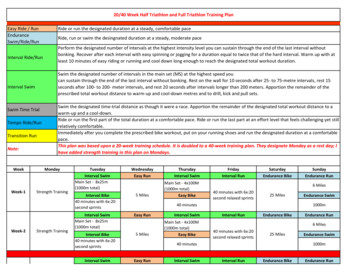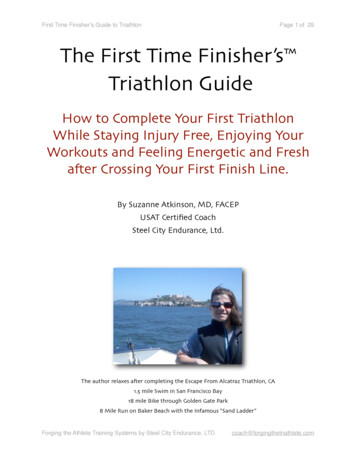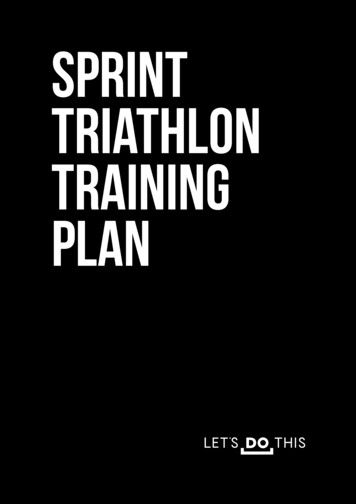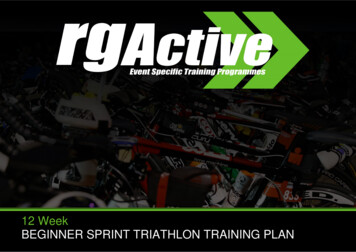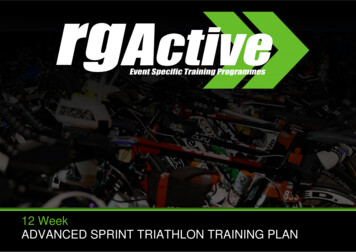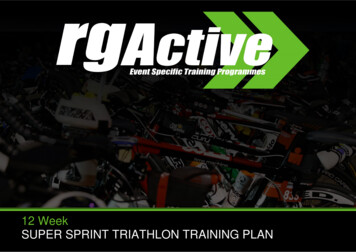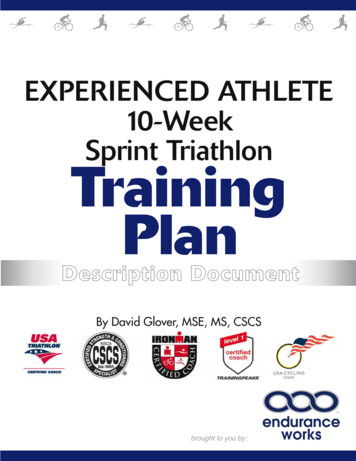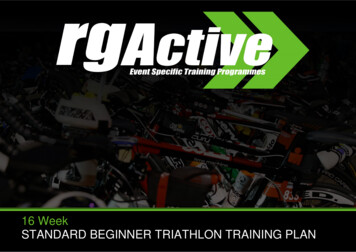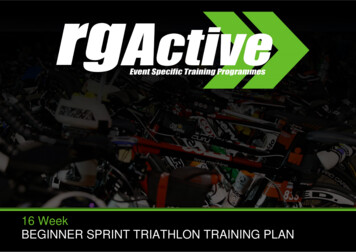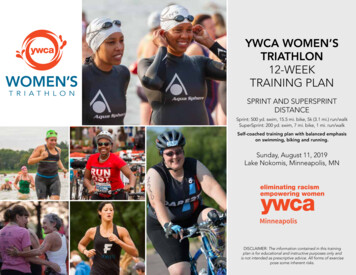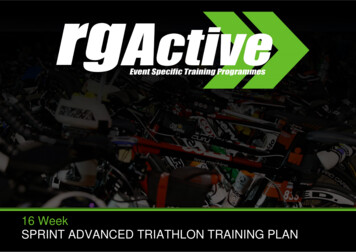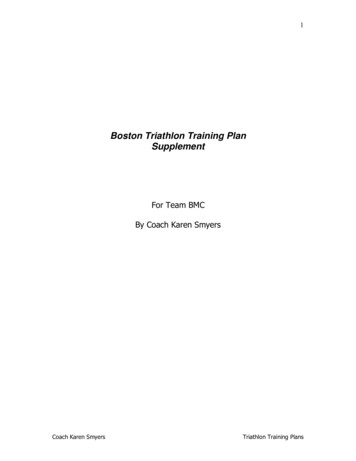
Transcription
1Boston Triathlon Training PlanSupplementFor Team BMCBy Coach Karen SmyersCoach Karen SmyersTriathlon Training Plans
2SUPPLEMENT CONTENTSWelcome and IntroductionPage 3Heart Rate Based TrainingPage 4The Schedule/Workout NotesPage 5Getting Through Your First Triathlon SwimPage 6Cycling Safety TipsPage 8Swimming DrillsPage 9Cycling DrillsPage 11Running DrillsPage 12Speedy TransitionsPage 14Strength RoutinePage 15EquipmentPage 18Notes on the Boston Triathlon CoursePage 20Coach Karen SmyersTriathlon Training Plans
3WELCOME!Welcome to Boston Medical Center’s Boston Triathlon training program. The following10-week training plan has been developed to help you prepare for and complete theBoston Triathlon on September 3rd. This program provides a schedule of workouts tohelp you balance the training required for three sports (swimming, biking and running) atthe same time. In addition, it will train you to be able to do these three sportsconsecutively! The race consists of a half-mile swim in the Boston Harbor, followed by a12-mile bike through the streets of Boston and along Memorial Drive, and finishes with a3-mile flat run through the South Boston waterfront area.Two workout schedules are included: one for beginners and one for advanced. Thebeginner schedule assumes that you are starting without much or any training in any ofthe three sports. If you can commit about 3-4 hours per week to training and yousystematically follow the schedule, you will be able to complete a sprint triathlon by theend of the ten weeks. The advanced schedule is for those athletes that already have somebackground in swimming, biking and running and wish to focus on getting faster at eachdiscipline.Each individual may begin the program with varying strengths and weaknesses. Someadjustment in distances may be necessary if you are already proficient in one of the threesports. You probably don’t need to decrease your training in any of the sports to stick tothe schedule (unless you need the time or energy to be able to add in the other twosports). A proficient runner may even want to combine the run training from theadvanced program with the swim and bike schedule from the beginner’s program.There is a lot of information to absorb in this packet, but we recognize that you may stillhave questions that you would like to address to a real, live coach. Coach Karen Smyers(a 23-year veteran of the sport and the 1995 Hawaiian Ironman Champion) will beavailable for questions and advice via email at MKandKS@comast.net. In addition,Coach Karen will be hosting two clinics in the upcoming weeks to give you some handson coaching and practice. These will be valuable opportunities to work on yourtechnique, learn about transitions and get more comfortable with open water swimming.We wish you good health and good spirits as you embark on this great challenge!Coach Karen SmyersTriathlon Training Plans
4Heart Rate Based TrainingIt is important that you know the proper intensity levels for different workouts. We usetwo ways to describe an intensity level. The first method bases the intensity on eachindividual’s heart rate (HR) zones. This method is the most precise and reliable methodbut it requires you to own and use your HR monitor and it requires you to have done aramp test to determine your lactate threshold (LT) and the corresponding zones correctly.(The oft-published method of using a formula of 220-your age is unreliable and is notrecommended.) The second method we use is perceived exertion. This is less precise butcan be used in the absence of the heart rate method.The following heart rate zones are used for describing workout intensity. If you haven’tbeen tested to determine your individual zones, go by the accompanying perceivedexertion description.PerceivedZone Training TypeHR RangeExertionE1Easy Aerobic/Base/Recovery25-40 below LTEasy (3-4)E2Aerobic Training15-24 below LTModerate (5-6)E3Tempo Training4-14 below LTSomewhat hard (7-8)E4Lactate Threshold TrainingLT /- 3Hard (8-9)E5Supra Threshold TrainingLT 3 to Max HRAll Out (10)Keep in mind what the goals of your training are: Develop your aerobic system to be able to complete the race distance in all threesportsBuild strength in order to withstand the rigors of swimming, biking and runningImprove technique in order to swim, bike, and run with efficiencyDetermine and become comfortable with pacing and HR zones in each sportLearn to transition from one sport to anotherBecome adept at using the gear required during a triathlonExtend the time that you are able to hold a given HR or paceDevelop confidence and mental toughness necessary to ensure you reach the finishline.Coach Karen SmyersTriathlon Training Plans
5The ScheduleAlthough the beginner program doesn’t require you to have been actively training in anyof the sports, it does assume that you are capable of doing all three sports—if you need tolearn to swim, for example, it is beyond the scope of this program. Take some swimlessons for a season from a swim instructor, and then you can embark on this trainingprogram.This schedule has been developed with the time constraints of a working person in mind.You can do some of the initial bike workouts in a spin class or on a bike ergometer at ahealth club, but it is important to get at least some experience biking outdoors on the bikeyou will use in the race so you get used to balancing, shifting, and getting on and off yourbike with ease. It is fine to do some of your run training on a treadmill if you prefer. Forswimming, if you are not a member of a health club with a pool, you may be able to findpool time at a local Y or high school. Walden Pond in Concord is a popular spot for openwater practice.In addition to the scheduled workouts in swimming, biking, and running, there is a list ofstrength exercises that would be very beneficial as a supplemental workout. Doing theseexercises 2-3 times/week will add 1-1.5 hours to your weekly training time.Finally, before embarking on the rigors of any training program, you should have an OKfrom your physician.Workout NotesThe schedule generally calls for just one workout per day. If you have to miss a day forsome reason or if you really want to have one day off every week, it is fine to double upsometimes and do two workouts in a day if you can fit them in. It is also fine to shufflearound the workouts to fit your particular schedule (if you have access to a pool onTuesday and Thursday rather than Monday and Friday for example). However, since youare only doing 2-3 workouts per week in each sport, it is best if they are spread outthroughout the week rather than lumped together. Even though you are training everyday, having a day off from the specific sport gives you valuable recovery time.You will find that cross-training (training for more than one sport at a time) is amarvelous way to build fitness without the overuse injuries and burnout that you may getfrom just training in a single sport. Enjoy the training!Coach Karen SmyersTriathlon Training Plans
6Getting Through Your First Triathlon SwimThe swim portion of a triathlon tends to be the segment that gives first-timers the mostanxiety. There is a good reason--on the bike ride, you can coast when you are tired, onthe run leg, you can walk if you need a break, but on the swim if you are tired, youroptions seem rather limited.the phrase “sink or swim” comes to mind.But that is a misleading perception that adds to people’s anxieties about the swimsegment. Did you know that it is perfectly legal to hold on to a boat or surfboard to catchyour breath as long as you are not making progress? You can also float, tread water, bob,or even stand up--if you are fortunate enough to be in shallow water. If your first race isin a pool, you have even more options.The swim course in Boston will be lined with volunteers in kayaks or on surfboards justin case someone needs help during the swim. All you need to do is wave your arm tosignal that you need assistance. Once people realize that if they get into trouble, there isa fallback position, it eases their minds considerably.Ironically, it is anxiety itself that contributes to the difficulty of the swim. Two keys togood swimming are being relaxed in the water and having controlled breathing. Anxietyusually has the opposite effect on both. Thus if you can lessen your anxiety by beingprepared, your swimming will improve.Here are some tips to help you with your preparation.Prepare The first step in being prepared is working up to the distance you must swim inthe race in your training. It is even better if you can do it in the open-water to mimic raceconditions. The more physically prepared you are, the less anxiety you should feel. Onrace day, keep reminding yourself of the training you have done.Know the Course Take the time to check out the layout of the buoys on race morning.Don’t be surprised if what looked like a perfect triangle on the course map looks morelike a giant amoeba from shore. Try to find some landmarks on shore that you may needto aim for to keep you oriented. If you find yourself getting disoriented on the swim, it isbest to stop swimming and reorient yourself. There is nothing worse than swimming afew hundred yards in the wrong direction. The Boston Triathlon course is pretty simple:you swim around the pier that the World Trade Center is built on. You are always quiteclose to the pier and the course only requires two left hand turns.See Clearly Make sure you have a pair of goggles that fit you and are appropriate for theday. At shortly after sunrise when most races start, the sun can be right above the watercausing a glare that makes visibility tricky. A smoke-tinted lens will help cut the glare.Conversely, if it is overcast, the smoke-tinted lens may shroud you in darkness. Have aclear or orange-tinted lens available for those conditions.Coach Karen SmyersTriathlon Training Plans
7Your goggle fit is important too. If your goggles give you a headache or leave lines onyour face for several hours after use, they are too tight. If they keep leaking, trytightening the straps or adjusting the nosepiece. If adjustments don’t make themcomfortable and leak-proof, try a different model that may fit your face better.To keep goggles from fogging, put a little saliva (i.e. spit!) into your dry goggles, slosh itaround and then rinse lightly in the water before putting them on.Seed Yourself The start of the swim can set the tone for your whole race. If you are oneof the better swimmers, by all means start near the front of your group. You don’t wantto swim through or over slower people anymore than they want you swimming overthem. If you are a slower swimmer or one who is more concerned with finishing withoutwater up your nose than what your time is, then start near the back of your wave or off tothe side where there is less congestion.Stay Cool Be prepared for “incidental contact” with other swimmers. Keep in mind thatno one is going out of his or her way to clobber you--they are trying to find clear waterjust as desperately as you are. If you get in a situation in which one swimmer keepsbumping or hitting you, give them a wedgie. Just kidding, stop and let them go by andcontinue your swim in more peaceful surroundings. (But make sure you re-pass them onthe bike.)Calm Yourself If you do begin to panic, have a plan to calm yourself. Focus onbreathing in and out slowly and deeply. Tread water or hold on to something until youare breathing calmly and regularly again. . Often keeping your head above water for afew strokes will help this. Try to envision how you swim in training and imagine you arethere. Just take it a few strokes at a time if that is what it takes—the important thing is toget to the finish.Coach Karen SmyersTriathlon Training Plans
8Cycling Safety Tips Always wear your properly-fitted helmet whenever you are on your bike.Make sure your tires are inflated (they should be hard to depress with your thumb)Be prepared to change a flat: carry a bike pump or C02 cartridge, spare tube andpatch kit, and tire irons.If you aren’t prepared to change a flat, be sure to carry a cell phone and cab fare!Have a water bottle cage to carry a water bottle with you.Ride defensively: assume that cars don’t see you until you see them acknowledgeyou.Follow the rules of the road and use hands signals to show your intentions in advance.Carry some ID and some emergency money.Cycling gloves and sunglasses can protect your hands and eyes and add comfort.Avoid puddles that you can’t see the bottom of—they often are potholes filled withwater.Make sure your hands are in a good position to brake when approaching intersectionsor dangerous situations.Ride single file if there is traffic on the road.When braking, practice feathering your brakes slowly (usually front then back) toavoid skidding or flipping over your handlebars.When turning a corner when the bike has momentum, learn to lean your bike into theturn rather than turning your handlebars.Practice your bike handling on quiet roads before venturing into busy areas or a race.Coach Karen SmyersTriathlon Training Plans
9Swimming Drills and VisualizationDrills are an effective means of improving your swim stroke; the best time of year towork on your stroke is in the pre-season before bad habits are engrained. By breakingdown the stroke into its parts, you can concentrate on one thing at a time. Repetition ofcorrect segments of your stroke is key to incorporating correct technique into your wholestroke. When the program calls for “drills” choose a variety of the following. Payattention to which you need work on and which ones seem to improve your stroke themost and do these more often. Think about good stroke technique every time you swim!Swimming Visualization There are many good visualization tricks that can help yourtechnique. Here are a few of the most helpful.Strong Core, Relaxed Limbs When swimming, i
systematically follow the schedule, you will be able to complete a sprint triathlon by the end of the ten weeks. The advanced schedule is for those athletes that already have some background in swimming, biking and running and wish to focus on getting faster at each discipline. Each individual may begin the program with varying strengths and weaknesses. Some adjustment in distances may be .
